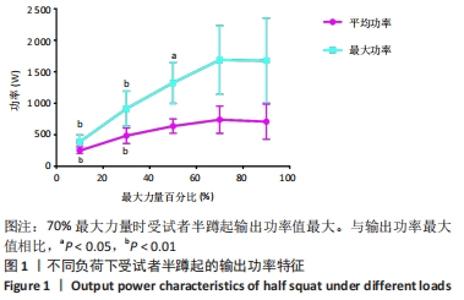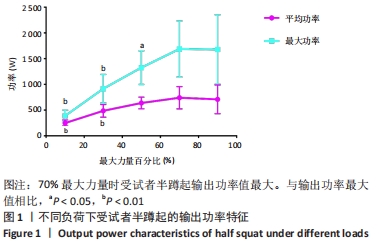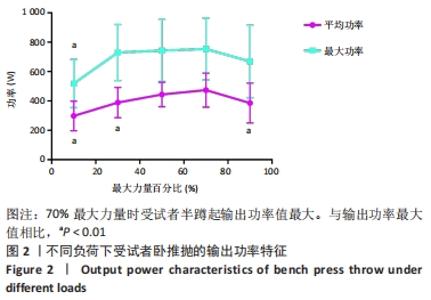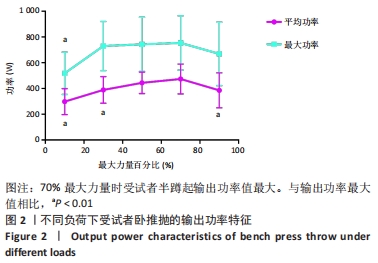Chinese Journal of Tissue Engineering Research ›› 2022, Vol. 26 ›› Issue (23): 3638-3643.doi: 10.12307/2022.661
Previous Articles Next Articles
Determination and characteristics of skeletal muscle output power in different strength training methods under optimal power load
Liang Meifu1, Guo Wenxia1, Zhao Ningning2, Pan Lei3
- 1China Institute of Sport Science, Beijing 100061, China; 2Hebei Institute of Sport Science, Shijiazhuang 050000, Hebei Province, China; 3College of Art and Physical Education, Hebei Institute of Communications, Shijiazhuang 051430, Hebei Province, China
-
Received:2021-08-05Accepted:2021-09-30Online:2022-08-18Published:2022-02-15 -
Contact:Pan Lei, Master, Lecturer, College of Art and Physical Education, Hebei Institute of Communications, Shijiazhuang 051430, Hebei Province, China -
About author:Liang Meifu, PhD, Lecturer, China Institute of Sport Science, Beijing 100061, China -
Supported by:the Fundamental Scientific Research Business Expenses of China Institute of Sport Science, No. Basic 21-33 (to LMF)
CLC Number:
Cite this article
Liang Meifu, Guo Wenxia, Zhao Ningning, Pan Lei. Determination and characteristics of skeletal muscle output power in different strength training methods under optimal power load[J]. Chinese Journal of Tissue Engineering Research, 2022, 26(23): 3638-3643.
share this article
Add to citation manager EndNote|Reference Manager|ProCite|BibTeX|RefWorks
| [1] DIEKHOFF T, GREESE J, KROHN M, et al. Movement Velocity as a Measure of Loading Intensity in Resistance Training. Int J Sports Med. 2010;31(5):347-352. [2] 李智伟,伍朝明,顾心雨,等.经颅直流电刺激下健康成人肌肉力量及耐力表现的Meta分析[J].中国组织工程研究,2021,25(29):4750-4756. [3] HILL AV. The heat of shortening and dynamics constants of muscles. Ser B-Biol Sci. 1938;126(843):136-195. [4] HUTTO LE. Measurement of the velocity factor and of athletic power in high school boys. Research Quarterly American Association for Health & Physical Education. 1938;9(3):109-128. [5] WILSON GJ, NEWTON RU, MURPHY AJ, et al. The optimal training load for the development of dynamic athletic performance. Med Sci Sports Exerc. 1993; 25(11):1279-1286. [6] LOTURCO I, SUCHOMEL T, BISHOP C, et al. One-repetition-maximum measures or maximum bar-power output: which is more related to sport performance? Int J Sports Physiol Perform. 2019;14(1):33-37. [7] PEREIRA LA, NIMPHIUS S, KOBAL R, et al. Relationship between change of direction, speed, and power in male and female National Olympic team handball athletes. J Strength Cond Res. 2018;32(10):2987-2994. [8] LAIRD CE, ROZIER CK. Toward understanding the terminology of exercise mechanics. Phys Ther. 1979;59(3):287-292. [9] SIEGEL JA, GILDERS RM, STARON RS, et al. Human muscle power output during upper-and lower-body exercises. J Strength Cond Res. 2002;16(2):173-178. [10] KRAEMER WJ, NEWTON RU. Training for muscular power. Phys Med Rehabil Clin. 2000;11(2):341-368. [11] NEWTON RU, KRAEMER WJ. Developing explosive muscular power: Implications for a mixed method training strategy. Strength Cond J. 1994;16(5):20-31. [12] LOTURCO I, BISHOP C, RAMIREZ-CAMPILLO R, et al. Optimum power loads for elite boxers: case study with the Brazilian national olympic team. Sports. 2018; 6(3):95-104. [13] FREITAS TT, CALLEJA-GONZÁLEZ J, CARLOS-VIVAS J, et al. Short-term optimal load training vs a modified complex training in semi-professional basketball players. J Sports Sci. 2019;37(4):434-442. [14] CROSS MR, BRUGHELLI M, SAMOZINO P, et al. Methods of power-force-velocity profiling during sprint running: a narrative review. Sports Med. 2017;47(7):1255-1269. [15] MASON BRJ, ARGUS CK, NORCOTT B, et al. Resistance training priming activity improves upper-body power output in rugby players: implications for game day performance. J Strength Cond Res. 2017;31(4):913-920. [16] BEHM DG, YOUNG JD, WHITTEN JH, et al. Effectiveness of traditional strength vs. power training on muscle strength, power and speed with youth: a systematic review and meta-analysis. Front Physiol. 2017;8:423. [17] HAFF GG, TRAVIS NT. Essentials of Strength Training and Conditioning 4th Edition. Champaign (IL): Human Kinetics, 2015. [18] MUKAKA MM. A guide to appropriate use of correlation coefficient in medical research. Malawi Med J. 2012;24(3): 69-71. [19] BAS-VAN H, JULIA Z. The difference between countermovement and squat jump performance: a review of underlying mechanisms with practical applications. J Strength Cond Res. 2017;31(7):2011-2020. [20] BIRD SP, TARPENNING KM, MARINO FE. Designing resistance training programmes to enhance muscular fitness. Sports Med. 2005;35(10):841-851. [21] LOTURCO I, NAKAMURA FY, TRICOLI V, et al. Determining the optimum power load in jump squat using the mean propulsive velocity. PLoS One. 2015;10(10): e0140102. [22] CORMIE P, MCGUIGAN MR, NEWTON RU. Developing maximal neuromuscular power. Sports Med. 2011;41(2):125-147. [23] ALCARAZ PE, ROMERO-ARENAS S, VILA H, et al. Power-load curve in trained sprinters. J Strength Cond Res. 2011;25(11):3045-3050. [24] COMFORT P, MUNDY PD, GRAHAM-SMITH P, et al. Comparison of peak power output during exercises with similar lower-limb kinematics. J Trainol. 2016;5(1): 1-5. [25] 张晓英.渐进性抗阻力量训练对普通人群力量、最大摄氧量与最大有氧功率的影响[J].山东体育学院学报,2009,25(8): 65-67. [26] 郭仲娅.卧推与下蹲最大动作功率的负荷研究[D].西安:西安体育学院,2015. [27] HARRIS NK, CRONIN JB, HOPKINS WG. Power outputs of a machine squat-jump across a spectrum of loads. J Strength Cond Res. 2007;21(4):1260-1264. [28] TURNER AP, UNHOLZ CN, POTTS N, et al. Peak power, force, and velocity during jump squats in professional rugby players. J Strength Cond Res. 2012;26(6):1594-1600. [29] MCBRIDE JM, HAINES TL, KIRBY TJ. Effect of loading on peak power of the bar, body, and system during power cleans, squats, and jump squats. J Sports Sci. 2011;29(11): 1215-1221. [30] CAIA J, DOYLE T LA, BENSON AC. A cross-sectional lower-body power profile of elite and subelite Australian football players. J Strength Cond Res. 2013;27(10): 2836-2841. [31] 李岩.力量、功率及弹跳速度之间的关系研究-基于对不同负荷的一项SJ测试[J].天津体育学院学报,2013,28(6):508-512. [32] THOMAS GA, KRAEMER WJ, SPIERING BA, et al. Maximal power at different percentages of one repetition maximum: influence of resistance and gender. J Strength Cond Res. 2007;21(2):336-342. [33] LOTURCO I, PEREIRA L A, KOBAL R, et al. Power output in traditional and ballistic bench press in elite athletes Influence of training background. J Sports Sci. 2018;37(3):277-284. [34] BAKER D, NANCE S, MOORE M. The load that maximizes the average mechanical power output during jump squats in power-trained athletes. J Strength Cond Res. 2001;15(1):92-97. [35] SHEPPARD JEREMY M, YOUNG K. Using additional eccentric loads to increase concentric performance in the bench throw. J Strength Cond Res. 2010;24(10): 2853-2856. [36] BAKER DG, NEWTON RU. Adaptations in upper-body maximal strength and power output resulting from long term resistance training in experienced strength-power athletes. J Strength Cond Res. 2006;20(3):541-546. [37] BEVAN HR, BUNCE PJ, OWEN NJ, et al. Optimal loading for the development of peak power output in professional rugby players. J Strength Cond Res. 2010; 24(1):43-47. [38] SMILIOS I, SOTIROPOULOS K, BARZOUKA K, et al. Contrast loading increases upper body power output in junior volleyball athletes. Pediatric Exerc Sci. 2016;29(1): 103-108. [39] SILVA B, DE M, MAROCOLO M, et al. Optimal load for the peak power and maximal strength of the upper body in brazilian jiu-jitsu athletes. J Strength Cond Res. 2015;29(6):1616-1621. [40] SARABIA JM, MOYA-RAMÓN M, HERNÁNDEZ-DAVÓ JL, et al. The effects of training with loads that maximise power output and individualised repetitions vs. traditional power training. PLoS One. 2017;12(10):e0186601. [41] CRONIN J, SLEIVERT G. Challenges in understanding the influence of maximal power training on improving athletic performance. Sports Med. 2005;35(3):213-234. [42] BAKER D. Comparison of upper-body strength and power between professional and college-aged rugby league players. J Strength Cond Res. 2001;15(1):30-35. [43] MALISOUX L, FRANCAUX M, NIELENS H, et al. Stretch-shortening cycle exercises: an effective training paradigm to enhance power output of human single muscle fibers. J Appl Physiol. 2006;100(3):771-779. [44] MUÑOZ-LÓPEZ M, MARCHANTE D, CANO-RUIZ MA, et al. Load-, force-, and power-velocity relationships in the prone pull-up exercise. Int J Sports Physiol Perform. 2017;12(9):1249-1255. [45] CORMIE P, MCGUIGAN MR, NEWTON RU. Adaptations in athletic performance following ballistic power vs strength training. Med Sci Sports Exerc. 2010;42(8): 1582-1598. [46] FLORES FJ, SEDANO S, REDONDO JC. Optimal load and power spectrum during snatch and clean: differences between international and national weightlifters. Int J Perform Analysis Sport. 2017;17(4):521-533. [47] LOTURCO I, TRICOLI V, ROSCHEL H, et al. Transference of traditional versus complex strength and power training to sprint performance. J Human Kinet. 2014;41(1):265-273. [48] POTIAUMPAI M, GANDIA K, RAUTRAY A, et al. Optimal loads for power differ by exercise in older adults. J Strength Cond Res. 2016;30(10):2703-2712. [49] 唐玉成,吴卅.抗衰老功率训练研究进展[J].中国运动医学杂志,2011,30(5): 477-485. |
| [1] | Shui Xiaoping, Li Chunying, Li Shunchang, Sun Junzhi, Su Quansheng . Effects of aerobic and resistance exercises on brain-derived neurotrophic factor, nuclear factor-kappa B and inflammatory cytokines in skeletal muscle of type II diabetic rats [J]. Chinese Journal of Tissue Engineering Research, 2022, 26(5): 669-675. |
| [2] | Wang Yongchao, Wang Baochen, Wei Zhuying, Bao Chunyu, Liu Shijun, Meng Qinghua. Blood flow restriction method for inducing cross-education phenomenon and muscle function reconstruction [J]. Chinese Journal of Tissue Engineering Research, 2022, 26(17): 2762-2767. |
| [3] | Wang Susu, Li Lifeng, Zhang Yimin. Visualization analysis on research progress and hotspots of exercise therapy for sarcopenia in older adults in recent decade [J]. Chinese Journal of Tissue Engineering Research, 2022, 26(14): 2223-2230. |
| [4] | Huang Tao, Liu Xiaoyun, Deng Yuping, Li Yanbing, Zhong Shizhen, Huang Wenhua. Biomechanical properties of adult biceps and triceps under real-time dynamic stretching [J]. Chinese Journal of Tissue Engineering Research, 2022, 26(12): 1828-1833. |
| [5] | Li Cai, Zhao Ting, Tan Ge, Zheng Yulin, Zhang Ruonan, Wu Yan, Tang Junming. Platelet-derived growth factor-BB promotes proliferation, differentiation and migration of skeletal muscle myoblast [J]. Chinese Journal of Tissue Engineering Research, 2021, 25(7): 1050-1055. |
| [6] | Yu Langbo, Qing Mingsong, Zhao Chuntao, Peng Jiachen. Hot issues in clinical application of dynamic contrast-enhanced magnetic resonance imaging in orthopedics [J]. Chinese Journal of Tissue Engineering Research, 2021, 25(3): 449-455. |
| [7] | Guan Tianmin, Chen Xiangyu, Zhu Ye. Mechanics calculation method of lumbar spine considering muscle factors [J]. Chinese Journal of Tissue Engineering Research, 2021, 25(27): 4307-4311. |
| [8] | Peng Hongcheng, Hua Zhen, Wang Jianwei. MicroRNA-21 — an important regulator of bone regeneration and various bone diseases [J]. Chinese Journal of Tissue Engineering Research, 2021, 25(26): 4198-4203. |
| [9] | Chen Shi, Du Chao, He Xuemei, Zhou Xiangyu. Effect of proanthocyanidins on proliferation and differentiation of skeletal muscle satellite cells under hypoxic-ischemic condition [J]. Chinese Journal of Tissue Engineering Research, 2021, 25(26): 4130-4136. |
| [10] | Xue Qing, Tong Liangcheng, Yang Zhiwei, Wang Jianling, Zhao Lei, Zhou Sheng, Peng Sai, Li Ying. Epigallocatechin gallate alleviates skeletal muscle ischemia-reperfusion injury in rats [J]. Chinese Journal of Tissue Engineering Research, 2021, 25(26): 4145-4149. |
| [11] | Wang Zhen, Lin Haiqi, He Fei, Lin Wentao. Exercise activates skeletal muscle satellite cells: exercise prevention and treatment for age-related sarcopenia and muscle injury [J]. Chinese Journal of Tissue Engineering Research, 2021, 25(23): 3752-3759. |
| [12] | Liang Meifu, Qu Shuhua. Optimal power load forecasting of the skeletal muscle based on back propagation neural network [J]. Chinese Journal of Tissue Engineering Research, 2021, 25(23): 3641-3647. |
| [13] | Bai Shengchao, Gao Yang, Wang Bo, Li Junping, Wang Ruiyuan. Dynamic changes of mitochondrial function of the skeletal muscle after acupuncture intervention in rats with heavy load exercise-induced injury [J]. Chinese Journal of Tissue Engineering Research, 2021, 25(23): 3648-3653. |
| [14] | Yang Xinhua, Yan Yindi, Luo Xuguang, Yang Yanping, Li Hairong, Cui Huilin, Cao Ximei. Bmal1 and Clock regulate the development and differentiation of skeletal muscle [J]. Chinese Journal of Tissue Engineering Research, 2021, 25(20): 3130-3137. |
| [15] | Li Shang, Huang Xiang, Chen Ming, Lei Mingxing, Cheng Shi, Zhang Licheng, Yin Pengbin, Tang Peifu. Semaphorin 3A is expected to be a new target for the repair of skeletal muscle injury [J]. Chinese Journal of Tissue Engineering Research, 2021, 25(20): 3232-3238. |
| Viewed | ||||||
|
Full text |
|
|||||
|
Abstract |
|
|||||











